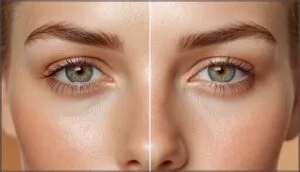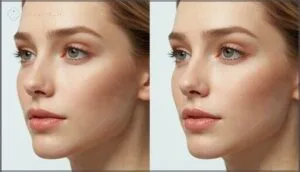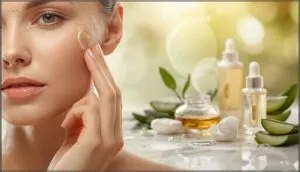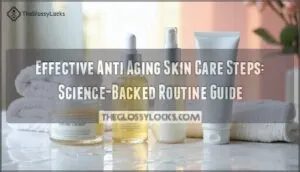This site is supported by our readers. We may earn a commission, at no cost to you, if you purchase through links.
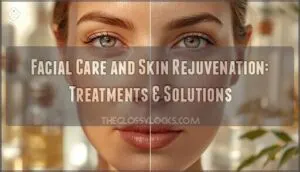
Your skin tells the story of every late night, every summer at the beach, and every birthday candle you’ve blown out. Around age 30, that story starts showing up in ways most people don’t expect—a crease that doesn’t quite fade after you smile, a roughness that wasn’t there before, or shadows under your eyes that makeup can’t quite hide.
These changes aren’t just cosmetic footnotes; they reflect deeper shifts in collagen production, cellular turnover, and structural support that accelerate faster than you’d think. Understanding facial care and skin rejuvenation means recognizing what’s actually happening beneath the surface—and knowing which interventions can genuinely restore what time takes away.
Table Of Contents
Key Takeaways
- Your skin begins showing visible aging signs—fine lines, texture changes, and volume loss—around age 30 due to declining collagen production (about 1% yearly), slowed cellular turnover, and cumulative sun damage that accounts for roughly 86% of premature aging.
- Daily sun protection with SPF 15+ and consistent cleansing with moisturizing form your non-negotiable foundation, while topical retinoids remain the gold standard for wrinkle reduction with visible improvements in 4-8 weeks.
- Professional treatments like hyaluronic acid fillers, microneedling, and chemical peels address deeper structural concerns—volume loss, stubborn pigmentation, and texture issues—that home care alone can’t fully correct.
- Long-term results depend on maintaining your routine post-treatment with gentle products, broad-spectrum sunscreen, and regular follow-ups with medical aestheticians, since consistency matters more than expensive quick fixes.
Signs of Facial Aging
Your skin tells a story, and the first chapters of aging often appear earlier than you might expect. Understanding what to look for helps you take action before changes become more pronounced.
Your skin’s aging story begins earlier than expected—understanding the signs helps you act before changes deepen
Let’s walk through the key signs that signal your skin is beginning its natural aging process.
Common Early Indicators
Fine lines often appear earlier than you’d think—sometimes by your early twenties, especially around the eyes where skin is thinnest. You might notice crow’s feet from smiling or subtle texture changes that catch the light differently.
Sun damage accelerates these shifts, with pigmentation and wrinkles showing up faster after years of UV exposure. Your eyes usually tell the story first.
Loss of collagen, which leads to facial volume loss, can also contribute to these early signs of aging.
Changes in Skin Texture and Tone
As your skin ages, texture and tone shift in measurable ways. Epidermal turnover slows—sometimes by half—leaving surfaces rougher and less radiant. Collagen loss leads to dullness, while pores expand and tone unevenness emerges, especially on cheeks and forehead. Hyperpigmentation trends upward with sun exposure, and skin irregularities become harder to ignore.
These changes in skin texture, tone, and pigmentation are key targets for effective skin rejuvenation. The dermis loses thickness during aging.
Volume Loss and Facial Contours
Beyond texture changes lies a deeper shift: your face literally loses shape over time. Fat pad atrophy begins around age 30, flattening cheeks and deepening nasolabial folds in most people by 50. Bone density loss undermines support structures, while collagen reduction—about 1% yearly—further compromises firmness. Weight fluctuation accelerates these changes, impacting facial attractiveness and aging perception.
Key volume loss patterns include:
- Cheek hollowing affects 80% of individuals over 60
- Midface descent creates jowl prominence in over 60% of those past 55
- Temple and under-eye hollowing adds years to perceived age
- Loss of the youthful “ogee curve” in 92% of people over 60
Restoring volume and face contour requires targeted intervention. Dermal fillers like hyaluronic acid deliver immediate results, while injectables such as poly-L-lactic acid rebuild collagen gradually. Facial fat grafting offers lasting correction, with satisfaction rates above 85%.
Pigmentation and Sun Damage
While structure falters inside, your skin tells its own story on the surface. UV exposure accounts for roughly 86% of melanomas, making sun damage a genuine skin cancer risk—not just a cosmetic concern.
Chronic exposure triggers irregular melanin production, creating sunspots and skin discoloration that age you visibly.
Prevention strategies matter most, but treatment options like chemical peels and IPL therapy can reverse existing skin pigmentation disorders effectively.
Key Facial Care Practices
Building a strong foundation in facial care doesn’t require complicated routines or expensive products—it starts with a few essential habits done consistently. Your skin responds best to daily practices that protect, nourish, and gently maintain its natural barrier.
Let’s look at the core steps that form the backbone of any effective skincare routine.
Daily Cleansing and Moisturizing
Your skin care routine starts with two fundamentals that work harder than you might think. Daily cleansing removes the dirt, oil, and makeup that clog pores and disrupt your skin microbiome, while consistent moisturizing locks in hydration and strengthens your skin barrier. Together, they’re your first defense against premature aging and common skin health concerns.
- Choose gentle, fragrance-free cleansers matched to your skin type
- Cleanse twice daily—morning and before bed—to prevent buildup
- Apply moisturizer immediately after cleansing to seal in hydration
- Avoid common cleansing mistakes like using hand soap on your face
Studies show that proper skin cleansing and skin hydration improve everything from elasticity to oil balance. When you select appropriate skin care products and stick with your routine, you’re investing in long-term skin health. Even small improvements in product selection and routine impact can prevent eczema, reduce blemishes, and help anti-aging treatments work more effectively.
The hydration benefits extend beyond the surface—increased water intake combined with quality moisturizers enhances your skin’s resilience against environmental stress and promotes natural cell renewal.
Importance of Sun Protection
When it comes to guarding your skin against lasting damage, daily sunscreen use is non-negotiable. Both UVA and UVB rays accelerate premature aging and increase your skin cancer risk—broad-spectrum benefits protect you from both.
Apply SPF 15 or higher every morning, even on cloudy days, to shield against sun exposure that breaks down collagen and causes skin damage.
Your future complexion depends on consistent sun protection, so make it part of your routine today.
Home Exfoliation Techniques
To complement your skincare routine with professional treatments, regular skin exfoliation at home removes dead cells and refines skin texture. Consider these evidence-based approaches:
- DIY Scrubs: Oatmeal or sea salt provide gentle mechanical exfoliation
- Chemical Options: AHA and BHA dissolve dead cells without abrading your skin barrier
- Exfoliation Frequency: One to three times weekly prevents over-exfoliation risks
- Sensitive Skin: Limit sessions and choose antioxidants-rich formulas for protection
Choosing The Right Skincare Products
With 90% of women struggling to find products that work for their needs, ingredient awareness becomes your most powerful tool. Match formulas to your skin type—59% of consumers prioritize natural options, while ceramides and antioxidants maintain barrier health.
Product layering matters: apply thinnest to thickest consistency. Budget considerations and ethical sourcing don’t mean compromising results in your skincare routine.
Professional Skin Rejuvenation Treatments
When home skincare routines aren’t delivering the results you’re looking for, professional treatments can make a real difference.
Medical aestheticians and dermatologists offer sophisticated procedures that target deeper skin concerns, from stubborn pigmentation to texture issues and volume loss.
Let’s explore the most effective options available at medical spas and dermatology clinics today.
HydraFacial and Dermaplaning
Your skin’s transformation starts with choosing the right professional facial treatments. HydraFacial uses wet exfoliation and serum infusion to boost hydration by 70% over 12 weeks, while dermaplaning employs precise blade work to remove dead cells and fine hair instantly.
Both deliver an immediate glow without downtime, addressing concerns from acne management to skin texture improvements through complementary mechanisms.
Chemical Peels and Microdermabrasion
When your skin needs more than surface-level care, chemical peels and microdermabrasion offer deeper exfoliation methods for skin rejuvenation. Consider these facial treatments based on your goals:
- Peel depths range from light glycolic acid (results lasting 1-2 months) to medium formulations (up to 6 months)
- Microdermabrasion increases collagen density by 15-25% after eight sessions
- Treatment combinations often outperform single approaches
- Recovery times and safety profiles vary—microdermabrasion suits sensitive skin better
Microneedling and Light Therapy
For stubborn wrinkles and texture issues, microneedling and light therapy deliver results through collagen induction and targeted light wavelengths. Nearly 94% of patients see visible improvements, with treatment synergy boosting outcomes beyond standalone approaches.
Red light therapy enhances the healing process, while microneedling creates micro-channels for rejuvenation.
You’ll need to follow safety protocols carefully—temporary redness resolves quickly, but proper sun protection remains non-negotiable during your recovery.
Injectable Cosmetic Treatments
Beyond surface treatments, injectable cosmetic treatments address facial aging at a deeper structural level. Botox injections relax expression wrinkles, while hyaluronic fillers restore lost volume instantly.
Consider these strategic options:
- Dermal fillers for immediate facial rejuvenation and wrinkle reduction
- Fat dissolving injectables targeting stubborn chin fullness
- Combination therapies pairing collagen stimulation with neurotoxins
You’ll achieve natural-looking results when treatments match your specific anatomical needs.
Targeted Solutions for Aging Concerns
Aging doesn’t affect everyone the same way, which is why your treatment plan should address your specific concerns. Whether you’re dealing with wrinkles, lost volume, dark circles, or uneven pigmentation, targeted solutions can make a real difference.
Here’s how professional treatments tackle the most common signs of aging.
Reducing Wrinkles and Fine Lines
When fine lines start to appear, you have more options than you might think. Topical retinoids remain the gold standard—studies show they boost collagen production and visibly reduce wrinkles within weeks. Peptide serums complement retinoids beautifully, with clinical trials revealing that 58% of users see improvement after eight weeks. For deeper concerns, laser resurfacing and microneedling improve skin elasticity through controlled collagen induction. Preventative measures—like consistent sunscreen use and early intervention—protect your investment in facial rejuvenation, keeping anti-aging results sustainable long-term.
| Treatment Type | Best For | Expected Results |
|---|---|---|
| Topical Retinoids | Fine lines, texture | Visible improvement in 4-8 weeks |
| Peptide Serums | Early wrinkles, hydration | 58% see reduction after 8 weeks |
| Laser Resurfacing | Moderate to deep lines | Results in 2-4 weeks, ongoing improvement |
| Microneedling + RF | Texture, deep wrinkles | Collagen boost over 3-6 months |
Restoring Volume and Facial Contour
While smoothing wrinkles improves the surface, facial fillers and fat grafting restore what aging takes beneath—your natural facial contours. Hyaluronic acid injectables deliver immediate volume restoration, lasting 6 to 18 months. For longer-term contour enhancement, fat grafting retains 60–90% of transplanted volume.
Combining dermal fillers with skin tightening technologies like ultrasound produces enhanced lifting effects. Facial rejuvenation treatments work best when they address both texture and underlying structure.
Treating Under-Eye Hollows and Dark Circles
Undereye hollows and dark circles often appear as early as your mid-twenties, driven largely by hereditary factors and volume loss. Under eye fillers using hyaluronic acid restore depth and reduce shadowing, usually lasting 9–12 months.
For thorough eye rejuvenation, combining fillers with microneedling or laser therapy tackles both hollows treatment and pigmentation. These facial contouring approaches deliver natural-looking results with minimal downtime.
Correcting Pigmentation and Skin Tone
Pigment correction tackles hyperpigmentation, melasma, and pigmentary changes that deepen with age and sun exposure. Topical combinations with hydroquinone and tretinoin deliver up to 73% improvement in skin tone within eight weeks, while microneedling and chemical peels accelerate skin brightening.
For stubborn discoloration, low-level laser therapy reduces pigmentation changes in as few as two weeks, restoring tone enhancement and clarity.
Maintaining Results and Skin Health
Getting great results from facial treatments is just the beginning—keeping your skin healthy and youthful requires ongoing care and smart daily habits. The right post-treatment routine, combined with long-term strategies, helps you protect your investment and maintain that refreshed appearance.
Here’s what you need to know about preserving your results and building lasting skin health.
Post-Treatment Skincare Routines
After your treatment, your skin needs extra care—think of it as hitting the reset button on your routine. Start with gentle cleansing and fragrance-free moisturizers to support healing and skin hydration.
Apply broad-spectrum sunscreen daily; your skin is more vulnerable now. Avoid exfoliants and actives until you’ve healed.
Following these home skincare routines helps maintain skin health and protects your investment.
Long-Term Anti-Aging Strategies
Real skin longevity comes from consistency, not quick fixes. Your daily skin care routine should include antioxidants and retinoids to support cellular regeneration and collagen production.
Combine these with lifestyle interventions—regular exercise improves skin elasticity, while managing stress protects skin health maintenance.
Monitor clinical trends, but remember: antiaging skin treatments work best when paired with sun protection and balanced nutrition. Stay informed about risks monitoring as formulations evolve.
Professional Guidance and Follow-Up
Your skin’s success depends on expert partnership, not guesswork. An initial consultation with medical aestheticians provides skin analysis and professional skincare advice customized to your unique needs.
- Pre-scheduled follow-up appointments increase treatment adherence by 60%
- Medical-grade product oversight under professional guidance improves outcomes by 25-40%
- Patient education during visits enhances your skin care routine and long-term results
Follow-up benefits include adjusting treatments seasonally and catching complications early.
Building Confidence Through Facial Care
Your confidence isn’t just skin deep—it’s measurably connected to facial skin care. Research shows that 85% of people feel more self-assured after consistent self-care routines, while facial analysis and customized facial treatments reduce stress hormones.
Beauty and confidence intertwine through skin health benefits: clearer complexion, emotional wellness, and visible skin rejuvenation treatments. These confidence boosters transform how you see yourself and how readily you engage with the world around you.
Frequently Asked Questions (FAQs)
What causes adult acne and how to treat it?
Like a centuries-old battle, adult breakouts stem from hormonal acne, skin inflammation, and clogged pores.
Effective acne treatment combines topical therapies, natural remedies for acne prevention, and professional facial treatments like chemical peels for thorough skin rejuvenation.
How often should I change my skincare routine?
Seasonal adjustments every 3 to 4 months work well for most people, though your skin type matters. Watch for irritation signs and consider product rotation with actives. Professional advice helps tailor changes to your skin conditions.
Are expensive facial products worth the cost?
Price signaling often inflates costs beyond actual performance. Higher ingredient concentration and clinical evidence matter more than brand prestige.
Many affordable alternatives deliver comparable skin care results when formulated with proven active compounds for targeted solutions.
Can diet and hydration improve skin appearance?
Yes—dietary hydration and skin nutrients directly influence your skin’s appearance. Consuming antioxidant-rich rejuvenation foods aids collagen production and combats visible aging, while adequate water intake improves elasticity.
Conversely, an unhealthy diet accelerates antiaging concerns.
Whats the difference between retinol and retinoids?
Retinoids are vitamin A derivatives requiring prescription strength, while retinol is an over-the-counter retinoid needing two conversions to become active retinoic acid.
This makes it gentler but slower for antiaging skin rejuvenation treatments.
Conclusion
Think of your skin as a garden—what you plant today determines what blooms tomorrow. Consistent facial care and skin rejuvenation aren’t about chasing flawlessness; they’re about giving your skin the resources it needs to repair, renew, and thrive.
Whether you choose professional treatments or enhance your at-home routine, the key is consistency rooted in understanding. Your face reflects the care you invest, and that investment pays dividends in confidence and long-term resilience.
- https://www.grandviewresearch.com/industry-analysis/facial-skincare-market-report
- https://www.tricociuniversity.edu/beauty-blog/skincare-industry-statistics-2025-u-s-market-overview/
- https://www.latrenta.com/blog/skin-tightening-without-surgery-the-most-effective-options-in-2025-supporting-statistics-on-treatment-efficacy
- https://jamanetwork.com/journals/jamadermatology/fullarticle/407425
- https://www.futuremarketinsights.com/reports/facial-care-products-market

